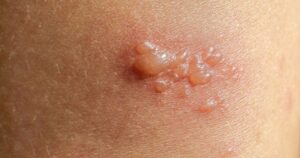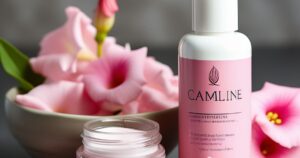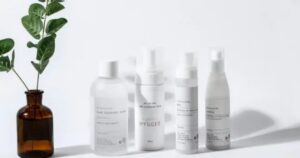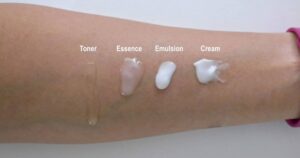Combination skin is a skin type characterized by a mix of different skin conditions in different areas of the face. The causes of combination skin can vary and may include a combination of genetic, hormonal, environmental, and lifestyle factors. Your skin type is partly determined by your genetics. If your parents or close relatives have combination skin, you may be more likely to have it as well.
Fluctuations in hormone levels, particularly during puberty, pregnancy, menstruation, and menopause, can affect the skin’s oil production. Hormonal imbalances can lead to an oily T-zone (forehead, nose, and chin) and drier or normal skin in other areas.Dry and cold weather can lead to dehydration, causing the skin to become dry in certain areas. On the other hand, hot and humid weather may trigger increased oil production in the T-zone.
Indications of Combination Skin
Combination skin is characterized by a diverse array of signs across different areas of the face. The most common indicator is a distinct contrast between the T-zone—comprising the forehead, nose, and chin—which tends to be oilier and prone to blemishes, and the cheek and eye areas, which may exhibit normal or dry skin tendencies.
Individuals with combination skin often notice enlarged pores and increased oil production in the T-zone, accompanied by occasional acne breakouts. The cheeks, however, may appear dry, flaky, or normal. Managing combination skin requires a balanced skincare routine that addresses both the oiliness and dryness, ensuring proper hydration and targeted treatments for specific areas to achieve an overall harmonious complexion.
Skin Care Routine For Combination Skin
Creating an effective skincare routine for combination skin involves addressing both oily and dry areas while maintaining balance. Here’s a suggested routine:
- Use a mild, fragrance-free cleanser to avoid stripping natural oils from the skin.
- Cleanse twice daily, morning and night, to remove impurities without over-drying.
- Incorporate a gentle exfoliator 2-3 times a week to remove dead skin cells and prevent clogged pores.
- Choose a chemical exfoliant with ingredients like alpha hydroxy acids (AHAs) or beta hydroxy acids (BHAs) for a more balanced approach.
- Use a alcohol-free, hydrating toner to rebalance the skin’s pH levels.
- Look for ingredients like hyaluronic acid or glycerin to add moisture without making the skin overly oily.
- Apply a lightweight, hydrating serum to address specific concerns. For the T-zone, opt for oil-free or mattifying serums with ingredients like niacinamide. For drier areas, use serums with hyaluronic acid or ceramides to boost moisture.
- Choose a non-comedogenic moisturizer that is suitable for combination skin. Gel-based or water-based moisturizers work well for the oily areas, while creamier formulations can be used on drier parts of the face.
- Apply a broad-spectrum sunscreen with at least SPF 30 every morning, regardless of weather. Look for a product that is oil-free and suitable for sensitive skin.
- For occasional breakouts in the T-zone, use targeted treatments with ingredients like salicylic acid or benzoyl peroxide.
- For dry patches, consider using a hydrating overnight mask or spot treatment.
- Use a hydrating mask for the dry areas and a clay mask for the T-zone to maintain balance.
- Incorporate these masks into your routine once or twice a week.
- Stay well-hydrated by drinking enough water.
Consume a balanced diet rich in fruits, vegetables, and essential fatty acids to support overall skin health.
Skin Care Products for Combination Skin
When choosing skincare products for combination skin, it’s important to look for ingredients that address both oily and dry aspects while maintaining a balance. Here are some key ingredients to consider:
Hyaluronic Acid helps hydrate the skin without adding excess oil.Suitable for all skin types, including dry areas.
Niacinamide (Vitamin B3) regulates oil production and helps improve the appearance of pores.Soothes and moisturizes without clogging pores.
Salicylic Acid exfoliates and unclogs pores, making it effective for the T-zone prone to breakouts. Helps control oil production.
Glycolic Acid (AHA) exfoliates and promotes cell turnover, beneficial for both dry and oily areas. Improves skin texture and tone.
Ceramides strengthens the skin barrier and retains moisture. Beneficial for dry or flaky areas.
Retinol promotes collagen production and cell turnover. Can be beneficial for both oily and dry areas, but start with lower concentrations to avoid irritation.
Glycerin attracts and retains moisture in the skin. Suitable for hydrating without causing excessive oiliness.
Clay (Kaolin or Bentonite) absorbs excess oil and impurities from the T-zone. Can be used in masks or cleansers for oil control.
Skincare Routine for Combination Skin With Acne
Creating an effective skincare routine for combination skin with acne involves addressing both oiliness and breakouts while maintaining hydration and balance. Here’s a suggested routine:
Gentle Cleanser
Use a mild, fragrance-free cleanser to wash your face twice daily.
Look for a cleanser containing salicylic acid to help control oil and treat acne.
Exfoliation
Incorporate a chemical exfoliant with salicylic acid 2-3 times a week to unclog pores and prevent breakouts.
Avoid physical exfoliants, as they can irritate acne-prone skin.
Toning
Use a gentle, alcohol-free toner to rebalance the skin’s pH levels.
Look for ingredients like witch hazel or niacinamide to help soothe and control oil.
Acne Spot Treatment
Apply a targeted treatment with benzoyl peroxide or salicylic acid to individual acne spots.
Use as needed, following the product instructions.
Serums
Use a lightweight, oil-free serum containing niacinamide to control oil and improve the appearance of pores.
Consider adding a vitamin C serum for its antioxidant properties and potential to fade post-inflammatory hyperpigmentation.
Oil-Free Moisturizer
Choose a non-comedogenic, oil-free moisturizer to hydrate without clogging pores.
Look for ingredients like hyaluronic acid to maintain skin moisture.
Sunscreen:
Apply a broad-spectrum sunscreen with at least SPF 30 every morning, even on cloudy days.
Choose a sunscreen that is oil-free and labeled as non-comedogenic.
Weekly Masks
Use a clay mask 1-2 times a week to absorb excess oil in the T-zone.
Consider using a mask with sulfur or charcoal to help control acne breakouts.
Hydrating Masks (Optional)
If your skin experiences dryness, use a hydrating mask on the drier areas of your face.
Use as needed, typically 1-2 times a week.
Avoid Touching or Picking
Resist the urge to touch or pick at acne lesions to prevent further irritation and scarring.
Consult a Dermatologist
If acne persists or worsens, consider consulting a dermatologist for personalized advice and prescription medications.
Natural Remedies for combination skin
Natural remedies can be gentle and effective for combination skin, offering solutions for both oily and dry areas. Here’s a detailed list of all-natural remedies for combination skin:
Honey Cleansing
Raw honey is a natural cleanser that offers antimicrobial properties, making it effective for cleansing without stripping the skin of natural oils. Apply a small amount of raw honey to damp skin, massage in circular motions, and rinse with warm water. Honey helps retain moisture, making it suitable for both dry and oily areas.
Apple Cider Vinegar Toner
Raw, unfiltered apple cider vinegar is known for its balancing properties. Mix equal parts of apple cider vinegar and water to create a toner. Apply with a cotton ball after cleansing to balance the skin’s pH, control excess oil, and address acne. Adjust the dilution if you have sensitive skin.
Aloe Vera Gel Moisturizer
Aloe vera gel is a natural moisturizer with soothing properties. Use pure aloe vera gel as a lightweight moisturizer, particularly on dry or irritated areas. Ensure the product is free from added chemicals or fragrances. Aloe vera’s natural composition is gentle on the skin and helps maintain hydration.
Oatmeal Exfoliating Scrub
Oats are a gentle exfoliant that can help remove dead skin cells without causing irritation. Create an exfoliating scrub by mixing finely ground oats with water or yogurt. Gently massage onto damp skin, focusing on the T-zone, and rinse off. This helps to keep the skin smooth and fresh.
Green Tea Face Mist
Green tea is rich in antioxidants and has anti-inflammatory properties. Brew green tea, let it cool, and transfer it to a spray bottle for a refreshing face mist. Spritz it on your face throughout the day to soothe inflammation and provide a mild astringent effect.
Jojoba Oil for Moisturizing
Jojoba oil closely resembles the skin’s natural sebum, making it an excellent moisturizer for combination skin. Apply a few drops of jojoba oil to damp skin to provide hydration without clogging pores. It’s particularly suitable for maintaining balance in both dry and oily areas.
Yogurt and Honey Face Mask
Yogurt provides a gentle exfoliation and contains lactic acid, which can help improve skin texture. Mix plain yogurt with raw honey to create a hydrating face mask. Apply evenly to the face and leave it on for 15-20 minutes. This mask can help moisturize and refresh the skin.
Rosewater for Toning
Rosewater acts as a natural toner with mild astringent properties. Apply rosewater to your face using a cotton ball after cleansing to help balance oil production and soothe the skin. Rosewater also imparts a gentle and pleasant fragrance.
Cucumber Slices for Eyes
Cucumber slices are a classic remedy for reducing puffiness and soothing the eye area. Place cool cucumber slices on your eyes and relax for 10-15 minutes. This natural remedy can be especially beneficial for hydrating and refreshing dry patches around the eyes.
Tea Tree Oil Spot Treatment
Tea tree oil is known for its antimicrobial properties, making it effective for spot treating acne. Dilute a small amount of tea tree oil with a carrier oil and apply it to individual acne spots using a cotton swab. Use this treatment sparingly and avoid applying it to large areas.
Chamomile Steam
Chamomile has anti-inflammatory and soothing properties. Boil water, add chamomile flowers, and create a tent with a towel to steam your face over the chamomile-infused water. This steam can help calm the skin, making it suitable for both oily and dry areas.
Diet and Hydration
Maintain a balanced diet rich in fruits, vegetables, and essential fatty acids to support overall skin health. Drink an adequate amount of water to stay hydrated, as hydration plays a crucial role in maintaining the balance of combination skin. A healthy diet contributes to the skin’s natural radiance and resilience.
Skin Care for Men With Combination Skin
Men with combination skin need a skincare routine that addresses both oily and dry areas while keeping it simple and effective. Here’s a suggested skincare routine tailored for men with combination skin:
- Gentle Cleanser: Use a mild, fragrance-free cleanser specifically formulated for combination skin. Cleanse your face twice a day, in the morning and evening, to remove impurities without over-drying.
- Exfoliation (2-3 times a week): Incorporate a gentle exfoliator into your routine to remove dead skin cells and unclog pores. Look for products with salicylic acid or glycolic acid, which are effective for combination skin.
- Toning: Apply a toner with ingredients like witch hazel or chamomile to rebalance the skin’s pH levels. This step helps control excess oil in the T-zone and soothes dry areas.
- Oil-Free Moisturizer: Choose a non-comedogenic, oil-free moisturizer to hydrate the skin without making it greasy. Look for ingredients like hyaluronic acid to maintain moisture balance.
- Spot Treatment (if necessary): Use a targeted spot treatment with ingredients like salicylic acid for occasional breakouts in the T-zone. Apply as needed, following the product instructions.
- Sunscreen: Apply a broad-spectrum sunscreen with at least SPF 30 every morning, even on cloudy days. Choose a sunscreen that is oil-free and suitable for daily use.
- Hydrating Mask (1-2 times a week): Use a hydrating mask on dry areas once or twice a week to provide an extra boost of moisture. Look for masks containing ingredients like hyaluronic acid or aloe vera.
- Weekly Clay Mask (1-2 times a week): Incorporate a clay mask into your routine to absorb excess oil in the T-zone and prevent breakouts. Use once or twice a week, depending on your skin’s needs.
- Clean Shaving Routine: If you shave, use a gentle shaving cream or gel. Consider shaving after a warm shower to soften the beard, and use a sharp, clean razor. Follow up with a soothing, alcohol-free aftershave to prevent irritation.
- Balanced Diet and Hydration: Maintain a healthy diet rich in fruits, vegetables, and lean proteins. Stay well-hydrated by drinking enough water to support overall skin health.
- Avoid Harsh Products: Avoid using harsh products that can strip the skin of its natural oils. Opt for products with gentle formulations suitable for combination skin.
- Consistency is Key: Consistency is crucial in any skincare routine. Stick to your routine and give products time to show results. Be patient, and don’t overuse or switch products too frequently.
Conclusion










